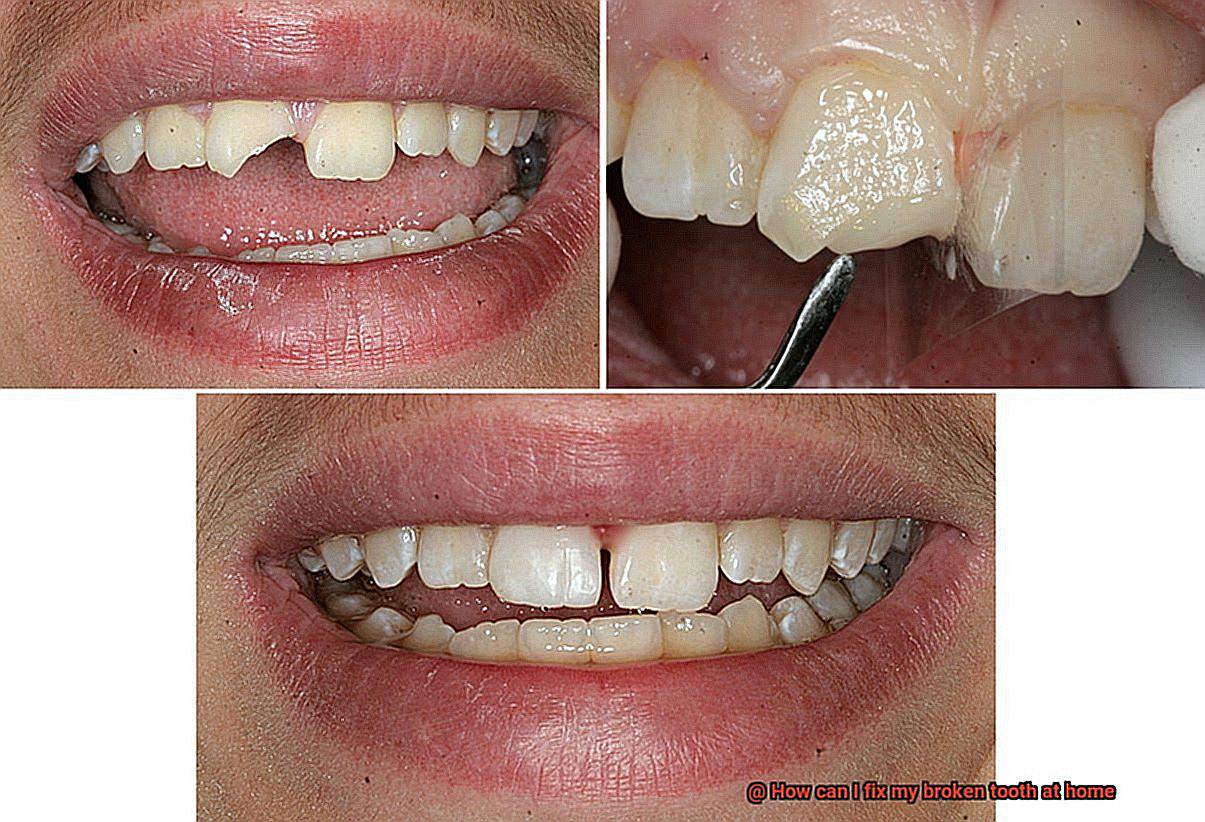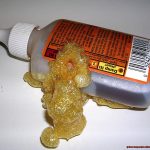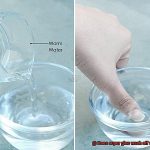Dealing with a broken tooth can be a real pain, both literally and figuratively. While it’s always best to see a dentist for proper care, there are a few home remedies you can try to manage the situation until you can get professional help. In this blog post, we’ll explore some simple yet effective techniques to fix that broken tooth from the comfort of your own home.
From soothing the pain to making temporary repairs, we’ve got you covered. However, keep in mind that these methods are just temporary solutions and should never replace proper dental treatment.
So, let’s dive into these DIY dental care tips without wasting any more time.
Instruction and Relevant Information:
- Rinse with warm saltwater: Mix half a teaspoon of salt into eight ounces of warm water. Gently swish this magical concoction around your mouth to clean and disinfect the broken tooth area. Just remember not to go overboard with rinsing or apply too much pressure.
- Over-the-counter pain relief: If you’re experiencing discomfort, reach for some over-the-counter pain relievers like ibuprofen or acetaminophen. These little helpers can work wonders in alleviating the ache—just make sure to follow the recommended dosage instructions.
- Dental wax or sugarless gum: To create a makeshift shield between your tongue and the jagged edges of your broken tooth, grab some dental wax or sugarless gum and apply a small amount over the rough spots. This will prevent further damage and soothe any irritation or sensitivity.
- Cold compress therapy: If you notice swelling or facial pain near the broken tooth area, gently place a cold compress on your cheek for some quick relief. The coldness will help reduce inflammation and numb the area temporarily.
- Stick to soft foods: While waiting for that dentist appointment, steer clear of hard or crunchy foods that could worsen the damage. Opt for soft, easy-to-chew foods that won’t put any extra strain on your tooth.
Remember, these home remedies are just temporary fixes and should only be used until you can schedule an appointment with a dental professional. Seeking proper care is crucial to address the root cause of your broken tooth and prevent any further complications.
Seek Professional Dental Care
Contents
- 1 Seek Professional Dental Care
- 2 Temporary Measures for Emergency Situations
- 3 Over-the-Counter Dental Cement or Temporary Filling Material
- 4 Clean the Affected Area Thoroughly
- 5 Follow Instructions of the Dental Cement or Temporary Filling Material
- 6 Avoid Chewing on the Affected Side of Your Mouth
- 7 Take Over-the-Counter Pain Relievers
- 8 Maintain Good Oral Hygiene
- 9 Conclusion
Dealing with a broken tooth can be an agonizing and distressing experience. While it may be tempting to try home remedies or temporary fixes, seeking professional dental care is absolutely crucial for proper treatment and long-term solutions. In this comprehensive guide, we will explore the reasons why you should always consult a dental professional when dealing with a broken tooth.
The Importance of Professional Assessment:
When it comes to a broken tooth, only a dental professional possesses the expertise to provide an accurate diagnosis. Attempting to fix it at home without professional guidance can lead to further damage or complications. A dentist will assess the extent of the damage and identify any underlying issues that may have caused the breakage. By obtaining an accurate diagnosis, you can ensure that the right treatment plan is implemented from the start.
Expertise and Specialized Equipment:
Dentists undergo extensive training and education to provide the best possible care for broken teeth. They have access to specialized equipment and materials necessary for repairing broken teeth effectively. With their expertise, they can ensure that the treatment is done safely and efficiently, minimizing discomfort and optimizing results.
Treatment Options Offered by Dental Professionals:
Dental professionals offer a range of treatment options depending on the severity of the tooth breakage. These may include bonding, dental crowns, veneers, or root canal therapy. Each treatment option is carefully considered based on factors such as tooth location, condition, and patient preferences. By consulting a dentist, you can explore these options and choose the most suitable one for your unique situation.
Long-Term Benefits of Professional Dental Care:
Seeking professional help ensures long-term oral health and prevents future complications. Dental professionals can address any underlying issues that may have contributed to the tooth breakage, such as decay or gum disease. By addressing these problems, they can help preserve your natural teeth and maintain your overall oral health. Investing in professional dental care now can save you from potential pain and costly treatments in the future.
Finding a Reputable Dentist:
To find a reliable and experienced dentist in your area, consider checking online reviews, asking for recommendations from friends or family, or consulting local dental associations. It’s important to choose a dentist who makes you feel comfortable and confident in their abilities. By doing thorough research, you can find a dentist whom you can trust to provide exceptional care for your broken tooth.
Temporary Measures for Emergency Situations
Accidents happen, and sometimes they involve our teeth. Whether it’s a chipped tooth from biting into something hard or a broken tooth from a fall, it’s important to take immediate action to alleviate pain and prevent further damage. While seeking professional dental care should be your top priority, there are some temporary measures you can take at home to manage the situation until you can see a dentist. In this article, we will discuss these temporary measures and focus on one popular option – glue.
Rinsing with Warm Saltwater:
One of the first things you can do at home is rinse your mouth with warm saltwater. This helps clean the area and reduces the risk of infection. Dissolve half a teaspoon of salt in eight ounces of warm water, then swish the solution around your mouth for 30 seconds before spitting it out.
Applying a Cold Compress:
To reduce swelling and alleviate pain, apply a cold compress to the affected area. Wrap some ice cubes in a cloth and hold it gently against your cheek for about 15 minutes. Remember to take breaks to avoid damaging your skin.
Over-the-Counter Pain Relievers:
In cases where the pain is unbearable, over-the-counter pain relievers such as ibuprofen or acetaminophen can provide temporary relief until you can see a dentist. Follow the instructions on the packaging and consult your doctor if you have any concerns.
Controlling Bleeding:
If there is bleeding from the broken tooth or surrounding gum tissue, apply pressure with a clean gauze or cloth to control it. Hold the gauze firmly against the area for about 10 minutes, and if bleeding persists, seek immediate medical attention.
Avoiding Chewing on the Affected Side:
To prevent further damage, avoid chewing on the side of your mouth where the broken tooth is located. Stick to soft foods and avoid anything hard or sticky until you can receive professional treatment.
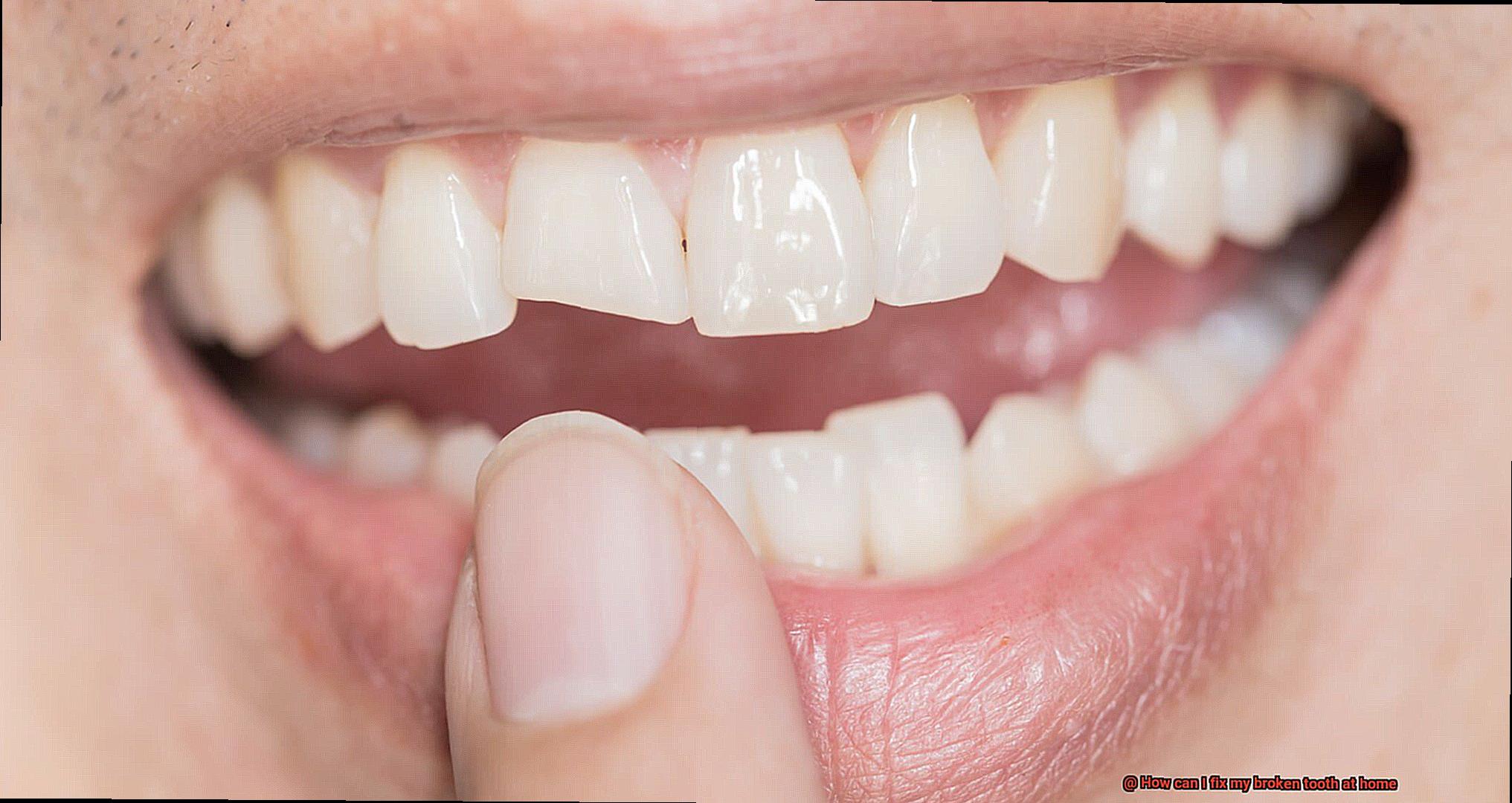
Temporary Dental Cement:
Now let’s talk about glue. Dental wax or temporary dental cement can be used to cover the sharp edges of a broken tooth. This provides temporary relief and protects your tongue and cheeks from getting injured. However, it’s important to note that these should only be used as a temporary measure until you can see a dentist.
Saving the Broken Tooth Fragment:
If a piece of the broken tooth has come off, it’s crucial to save it and bring it to the dentist. In some cases, they may be able to reattach the fragment, increasing the chances of preserving your natural tooth structure.
Over-the-Counter Dental Cement or Temporary Filling Material
Over-the-counter dental cement or temporary filling material can be a lifesaver when you find yourself with a broken tooth and no immediate access to a dentist. These products are designed to provide a temporary solution until you can seek professional dental treatment.
The beauty of over-the-counter dental cement or temporary filling material lies in its simplicity. These kits come with everything you need and clear instructions for application. It’s like a DIY project for your teeth. Just mix the paste or powder, apply it directly to the broken tooth, and shape it to fit comfortably. Voila. You’ve become a dental artist.
Not only are these products easy to use, but they also offer some level of protection and stability for your broken tooth. By filling in the gap or covering the exposed area, they can prevent further damage or sensitivity. And let’s not forget about the relief they provide from discomfort and pain. It’s like a soothing balm for your dental woes.
However, it’s crucial to remember that over-the-counter dental cement or temporary filling material should only be used as a temporary fix. They are not meant to replace professional dental treatment but rather act as a stopgap measure until you can see your dentist. So while they offer relief and protection, it’s essential to schedule an appointment with your dentist for a long-term solution.
Clean the Affected Area Thoroughly
You’ve found yourself in a sticky situation with a broken tooth. Don’t worry, I’m here to help you clean that affected area thoroughly before you embark on your glue adventure. Whether you’re a seasoned glue connoisseur or just looking for a temporary fix, it’s crucial to start with a clean slate. Let’s dive into the world of tooth cleaning and get that broken tooth back in shape.
First things first, rinse it out. Mix half a teaspoon of salt in a glass of warm water and swish it around your mouth for about 30 seconds. This simple step is like a refreshing ocean breeze for your mouth, disinfecting the area and reducing any swelling or pain. Ahh, can you taste the cleanliness?
Now, grab your trusty soft-bristled toothbrush and approach with caution. We’re not scrubbing away at a dirty pan here; we’re delicately cleaning a delicate tooth. Gently brush the broken tooth and the surrounding area, taking care not to disturb the fragile terrain. Think of it as a tender caress rather than an aggressive scrub.
Oh no, is there bleeding? Fear not, my friend. Rinse your mouth with cold water to calm the storm and then apply gentle pressure with a piece of gauze or a clean cloth. We’re giving your tooth a little hug, comforting it after the trauma it has endured.
But wait. Before you reach for any sharp objects or tools, let me stop you right there. We’re not sculpting a masterpiece here; we’re taking care of our oral health. Using sharp objects can lead to additional damage or injury, and we definitely don’t want that. So keep those tools in the toolbox.
Now that we’ve cleaned the area like dental superheroes, it’s time for some temporary solutions. Consider using an over-the-counter dental adhesive or temporary dental filling material. These magical products act as a protective shield for your broken tooth, providing stability and relief until you can see a dentist. It’s like giving your tooth a little spa treatment while you wait for the professional touch.
Remember, my glue enthusiast, these home remedies are temporary solutions and should not replace professional dental care. It’s crucial to seek dental treatment as soon as possible to prevent further complications. But hey, in the meantime, you can embrace your inner dental artist and become the hero of your own smile story with a little glue magic.
Follow Instructions of the Dental Cement or Temporary Filling Material
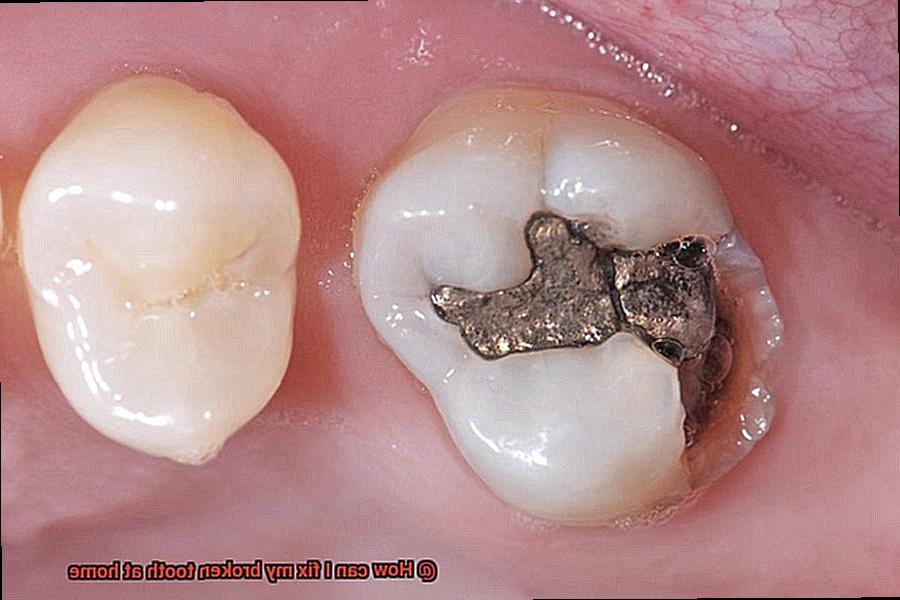
In times of a broken tooth requiring immediate attention, dental cement or temporary filling material can be a true lifesaver. However, it is crucial to handle these materials with care and adhere to the instructions provided by the manufacturer. This blog post will discuss the significance of following these instructions and provide a step-by-step guide to ensure a successful at-home temporary fix for your broken tooth.
Why Follow the Instructions?
- Safety: Dental cement and temporary filling materials contain specific ingredients that may require careful handling. By following the instructions, you reduce the risk of injury or adverse reactions, ensuring safe usage.
- Effectiveness: The instructions provided by the manufacturer are designed to help you achieve optimal results. Mixing ratios, application techniques, and setting times are all critical factors that influence the effectiveness of the material. Precisely following the instructions ensures proper adhesion, efficient gap filling, and adequate temporary relief.
- Comfort: Incorrectly applied dental cement or temporary filling material can cause discomfort or interfere with your bite. Following the instructions ensures that you apply the material in a way that promotes comfort, minimizes sensitivity, and avoids any disruption to your daily activities.
Step-by-Step Guide:
- Clean the area: Thoroughly clean the broken tooth and surrounding area using a toothbrush and toothpaste. Rinse your mouth with water to remove any debris or food particles, preparing a clean surface for application.
- Mix the material: Carefully follow the instructions to mix the dental cement or temporary filling material. Adhere to specified ratios and mixing times to achieve the desired consistency, ensuring an effective repair.
- Apply the material: Utilize a dental spatula or applicator provided with the product to apply the material to the broken tooth. Cover the entire break area, diligently filling gaps or cracks. Apply gentle pressure to guarantee proper adhesion.
- Smooth and remove excess material: Smooth out any excess material around the edges of the tooth using a moist cotton swab or your finger. This step is crucial in preventing discomfort or interference with your bite, ensuring a seamless repair.
- Allow the material to set: Follow the manufacturer’s instructions regarding the setting time. During this period, refrain from biting down on hard or chewy foods to prevent dislodging or damaging the repair.
- Test the repair: Once fully set, gently bite down on the repaired tooth to ensure there is no discomfort or issues with your bite. If any problems arise, consult your dentist for further advice.
Avoid Chewing on the Affected Side of Your Mouth
When a tooth warrior breaks a tooth, it’s crucial to avoid chewing on the affected side of the mouth. This isn’t just an old wives’ tale – it’s backed by solid science. Imagine this: you’re savoring a scrumptious meal when suddenly, CRUNCH. Your tooth shatters. Ouch. The natural instinct is to keep chomping away on that side, but resist the urge, my friend.
Why? Well, when you chew on the affected side, you’re subjecting the already damaged tooth to additional pressure and strain. Think of it like trying to lift weights with a sprained wrist – not a bright idea, right? The same concept applies here. Chewing on that side could further weaken your broken tooth, making it even more vulnerable.
To give your tooth a chance to heal and prevent further trauma, it’s best to avoid chewing on the affected side altogether. Instead, adapt and use the opposite side of your mouth for chewing. Admittedly, it may take some getting used to, but trust me, it’s worth it.
Now, we understand that avoiding that side completely isn’t always possible, especially when faced with your favorite foods. In such situations, consider using dental wax or temporary filling material as a protective barrier for your tooth. These temporary solutions act as cushions and can help safeguard against any accidental mishaps while you eat.
But remember, my fellow warriors, these are just temporary fixes. They don’t replace professional dental treatment. If you break a tooth, it’s crucial to consult a dentist for proper assessment and treatment. They are the real heroes who can guide you through the healing process and ensure your pearly whites are back in tip-top shape.
Take Over-the-Counter Pain Relievers
Experiencing the intense pain of a broken tooth can be unbearable, whether it’s the result of an accident or decay. In these situations, over-the-counter (OTC) pain relievers can offer much-needed temporary relief. However, it’s important to recognize that these medications only address the symptoms and do not fix the underlying issue of a broken tooth. In this article, we will delve into the benefits and risks associated with taking OTC pain relievers for a broken tooth. We will explore the types of medication available, potential side effects, and other important considerations to help you make an informed decision.
Types of Medication Available:
When it comes to dental pain caused by a broken tooth, nonsteroidal anti-inflammatory drugs (NSAIDs) are often recommended. These include familiar names such as ibuprofen and naproxen. These medications work wonders by reducing inflammation and alleviating pain. Another option is acetaminophen, a widely used pain reliever that can also help ease toothache discomfort. It’s crucial to follow the recommended dosage instructions on the packaging and consult a healthcare professional if the pain persists or worsens.
Benefits of OTC Pain Relievers:
OTC pain relievers serve as valuable allies in managing toothache discomfort while awaiting dental treatment. They provide temporary relief, allowing individuals to carry on with their daily activities despite the pain. NSAIDs and acetaminophen are easily accessible and affordable options found at most pharmacies. They effectively reduce inflammation and alleviate pain, making it easier to cope until professional help is sought.
Drawbacks and Considerations:
While OTC pain relievers offer temporary relief, they do not address the underlying issue of a broken tooth. Dental treatment is essential to fix the tooth and prevent further complications. Additionally, it’s important to be aware of potential side effects associated with these medications. NSAIDs can cause stomach irritation, ulcers, and an increased risk of bleeding, especially in individuals with certain medical conditions. Acetaminophen, when taken in excessive amounts, can lead to liver damage. It is crucial to adhere to the recommended dosage and consult a healthcare professional if any concerns arise or adverse effects are experienced.
Maintain Good Oral Hygiene
We all know that a broken tooth can be a real pain – both literally and figuratively. But fear not, because there’s a lot you can do to prevent and manage those pesky fractures. It all starts with maintaining good oral hygiene. So grab your toothbrush and let’s dive into the world of sparkling smiles.
Brushing like a boss:
Brush at least twice a day with a soft-bristled toothbrush and fluoride toothpaste. Gently remove plaque and bacteria from your pearly whites by brushing in circular motions, avoiding harsh scrubbing that could further damage a broken tooth.
Floss like a champion:
Don’t neglect the spaces between your teeth. Floss daily to clean those hard-to-reach areas and prevent cavities and gum inflammation that weaken tooth structures.
Power up with mouthwash:
An antibacterial mouthwash is like the secret weapon in your oral hygiene arsenal. It fights off bacteria, freshens breath, and reduces the risk of infection around broken teeth.
Regular dental check-ups:
Don’t skip those dental appointments. Regular check-ups allow dentists to identify any issues with broken teeth and provide appropriate treatment options.
Kick bad habits to the curb:
Smoking and excessive alcohol consumption stain your teeth and weaken enamel, making them more prone to breakage. Take a stand against these harmful habits for the sake of your oral health.
Nourish your teeth from within:
A balanced diet packed with calcium-rich foods like dairy products, leafy greens, and lean proteins helps keep your teeth strong. Avoid excessive sugar, as it feeds harmful bacteria that erode enamel and increase the risk of fractures.
Hydrate, hydrate, hydrate:
Water is your teeth’s best friend. Rinse away food particles and maintain saliva production by drinking plenty of water. It helps protect your teeth from decay.
Don’t use your teeth as tools:
Avoid using your teeth to open packages or crack nuts. It’s a recipe for disaster that can lead to unnecessary pressure and potential fractures.
Stress less for stronger teeth:
Managing stress levels is essential for good oral health. Stress can cause teeth grinding or clenching, weakening tooth structures and increasing the risk of fractures. Engage in stress-reducing activities like exercise or meditation.
PkejEmkgUy8″ >
Conclusion
Fixing a broken tooth at home may seem like a tempting idea, but it’s important to approach dental issues with caution. While there are temporary measures you can take to alleviate discomfort, such as rinsing your mouth with warm saltwater or applying a cold compress to reduce swelling, these remedies only provide temporary relief. They do not address the underlying problem and should not be seen as long-term solutions.
Attempting to fix a broken tooth at home can lead to further damage and complications. Dental professionals have the expertise and tools necessary to properly assess and treat dental issues. They can determine the extent of the damage, recommend appropriate treatments, and ensure proper oral hygiene practices are followed.
Ignoring a broken tooth or attempting DIY fixes can result in infection, decay, and even tooth loss. It’s crucial to seek professional dental care as soon as possible when faced with a broken tooth. Dentists have various treatment options available, including bonding, dental crowns, veneers, or root canal therapy if necessary.
Remember, your oral health is too important to leave in the hands of DIY remedies. Trust the professionals who have dedicated their lives to providing quality dental care. By seeking timely treatment from a dentist, you can ensure that your broken tooth is fixed properly and prevent further complications down the road.
So, don’t hesitate – reach out to your dentist today and let them guide you towards the best solution for fixing your broken tooth.

